The next-gen MacBook Pro with Retina Display Review
by Anand Lal Shimpi on June 23, 2012 4:14 AM EST- Posted in
- Mac
- Apple
- MacBook Pro
- Laptops
- Notebooks
Last year when I wrote about the new MacBook Airs I offered two forward looking paragraphs:
What happens from here on out is what's really interesting. Intel has already committed to moving the TDP of its mainstream parts from 35W - 45W down to 10 - 20W. Since the Air is the new mainstream Mac notebook, Apple has already made that move. The performance in this 10 - 20W segment is going to get much better over the next two years, particularly once Haswell arrives.
The Thunderbolt Display is the first sign of what's to come. Moving IO controllers and expansion into the display, and potentially even moving discrete GPUs out of the notebook are all in store for us. Apple is really ahead of the curve here, but it's easy to imagine a future where laptops become a lot more like the new Air and shift to a couple high bandwidth ports instead of numerous lower bandwidth connections.
Perhaps I was being too aggressive in the prediction of a couple of high bandwidth ports. After all, the next-generation MacBook Pro with Retina Display features four such IO ports (2 x Thunderbolt and 2 x USB 3.0). But you get my point. Gigabit Ethernet and Firewire 800 are both gone. The discrete GPU is still present but I suspect even its days are numbered, at least inside the chassis. The personal computer as we knew it for so long, is changing.
The personal computer is getting thinner, lighter, more integrated and more appliance-like. The movement is no longer confined to just Apple either. The traditional PC OEMs are following suit. Even Microsoft has finally entered the PC hardware business, something it threatened to do for years but hadn't until now. Distribution models will change, the lines between different form factors will continue to blur. What was once a mature industry is going through a significant transformation. It’s exciting but at the same time it makes me uneasy. When I first got into this industry everyone had stories of companies with great ideas that just didn’t make it. As we go through this revolution in computing I’m beginning to see, first hand, the very same.
Apple makes the bulk of its revenue from devices that don’t look like traditional personal computers. For the past couple of years I’ve been worried that it would wake up and decide the traditional Mac is a burden, and it should instead be in the business of strictly selling consumer devices. With its announcements two weeks ago in San Francisco, I can happily say that my fears haven’t come true. At least not yet.
It’s been a while since Apple did a really exciting MacBook Pro launch. Much to my surprise, even the move to Sandy Bridge, the first quad-core in a MacBook Pro, was done without even whispers of a press conference. Apple threw up the new products on its online store, shipped inventory to its retail outlets, updated the website and called it a day. Every iPhone and iPad announcement however was accompanied with much fanfare. The MacBook Pro seemed almost forgotten.
With its WWDC unveil however Apple took something that it had resigned to unexciting, dare I say uncool status, and made a huge deal about it. Two weeks ago Apple did the expected and offered relatively modest upgrades to all of its portable Macs, all while introducing something bold.
Apple calls it the MacBook Pro with Retina Display. You’ll see me refer to it as the next-gen MacBook Pro, Retina MacBook Pro, rMBP or some other permutation of these words.
After using it for the past two weeks I can honestly say it’s the best Mac Apple has ever built. And there’s a lot more to it than hardware.
Portability
If you were hoping for a 15-inch MacBook Air, that’s not what the rMBP is. Instead it is a far more portable 15-inch MacBook Pro. I have to admit I was a bit let down the first time I laid eyes on the next-gen MacBook Pro, it looks good but it doesn’t look all that different. The disappointment quickly faded as I actually picked up the machine and started carrying it around. It’s not ultra light, but man does it make the previous chassis feel dated.
While I never really liked lugging around the old MBP (and it always made me feel like the old fogey at tradeshows where everyone else had something 13-inches or smaller), carrying the rMBP is a pleasure by comparison. Pictures really don’t do it justice. The impressively thin display assembly or overall chassis thickness look neat in a photo but it’s not until you actually live with the rMBP that you can appreciate what Apple has done here. I carry around a 15-inch MacBook Pro because it’s my desktop, and as such it’s incredibly useful to have with me when I travel. For my personal usage model, the Retina MacBook Pro is perfect.
If your workload demands that you need the performance of a MacBook Pro and your lifestyle requires you to carry it around a lot, the reduction in thickness and weight alone will be worth the upgrade to the rMBP. If you spend most of your time stationary however, you’ll have to be sold on the display and internal characteristics alone. The bad news is if the design doesn’t get you, everything else will.

From left to right: 11-inch MacBook Air, 13-inch MacBook Air, 15-inch MacBook Pro, MacBook Pro with Retina Display
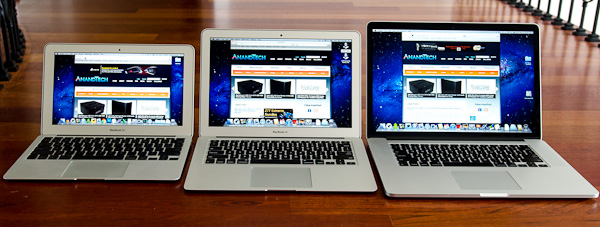
From left to right: 11-inch MacBook Air, 13-inch MacBook Air, MacBook Pro with Retina Display
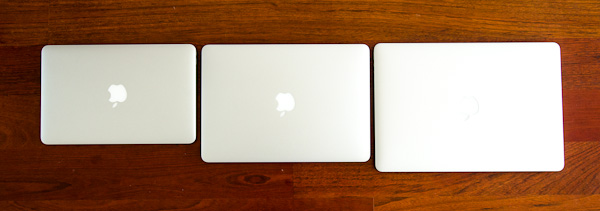
From left to right: 11-inch MacBook Air, 13-inch MacBook Air, MacBook Pro with Retina Display


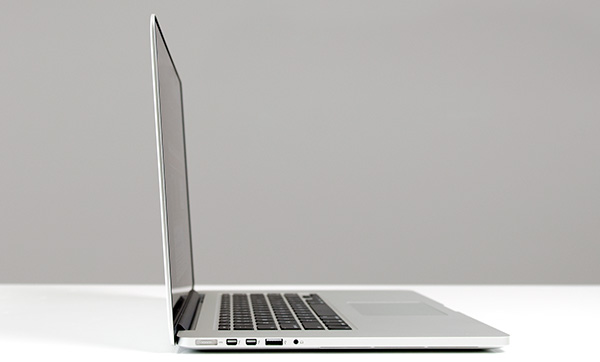
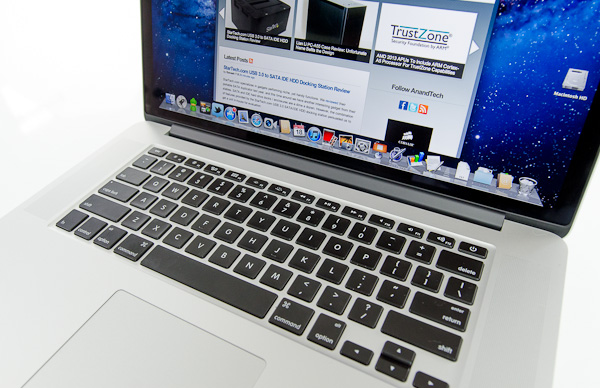
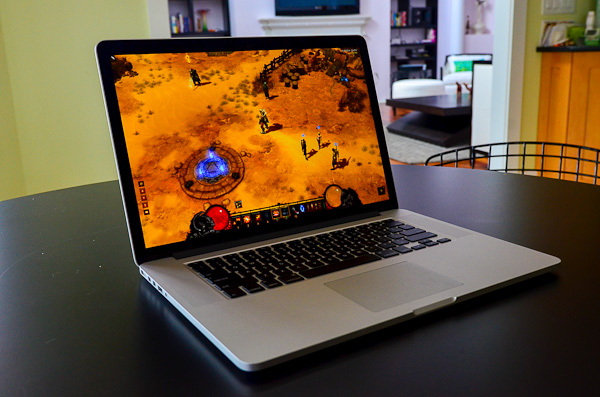
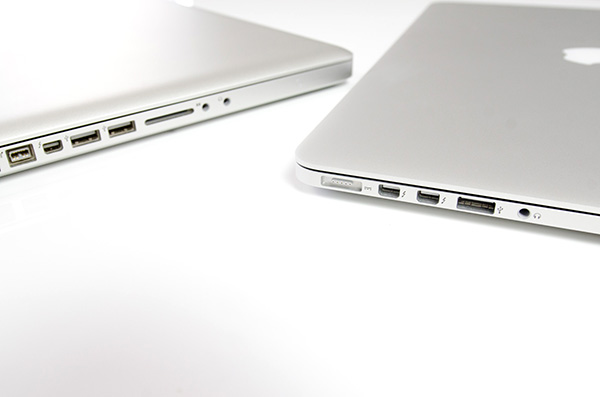
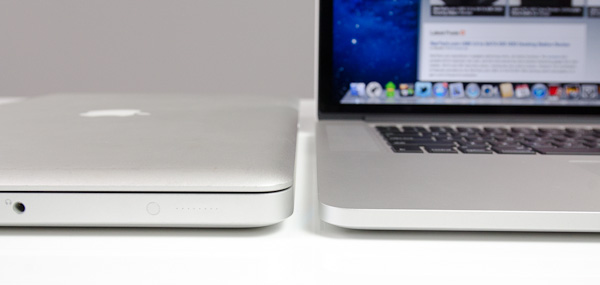








471 Comments
View All Comments
Super56K - Saturday, June 23, 2012 - link
Maybe talking paper specs on the software side it's 'the same' but really that's not even close. Dpi scaling is flaky in Windows anyways.And it's really not the same. It's rendered at double the resolution on a screen that actually has 4x's the pixels at the native 1440x900 res. Nobody else does that. Hell, it's rare to even find a 16:10 Windows laptop.
I don't own a MacBook anything, but some of you sound ridiculous in here going on about Sony laptops with 1080p screens
Spunjji - Tuesday, June 26, 2012 - link
What if I, the user, don't want my laptop rendering the display at a pointlessly high resolution just to scale it back down again? I understand the theory but the execution is utterly ridiculous.UpSpin - Saturday, June 23, 2012 - link
You're right, it wouldn't sell, because the issue is that Windows DPI scaling doesn't work so well. It also doesn't work perfectly in Mac OS (Chrome best example, they had to update it). And so will many older programs, which don't receive further updates, like Adobe Creative Suite <6 don't scale right (assumption)That's one reason that Apple released only one MacBook with a retina display, because the software isn't ready for DPI scaling yet. Apple was brave enough to do the step and force programers to integrate scaling in high res images in their programs because future MacBooks will have retina displays only.
No PC manuafcturer could have done such a step, they would have been blocked by the lack of proper scaling of Windows, rendering a high res display useless because of display errors. So Microsoft should have made Windows 7 resolution independent (just as all mobile OS are, which rely on DPI instead of absolute pixels), then PC manufacturers could have included high res displays which the customer could have used.
EnzoFX - Saturday, June 23, 2012 - link
MS Should have with Win7? Hardly. That was too long ago and there were no retina screens yet. Even 1080p screens were scarce. Remember that 99% were getting 1366x768 in their laptops.You're right in that Apple can sort of force developers to update apps for support. I do give them credit for usually implementing a solid stopgap. Their scaling for older apps is usually good enough without it being a bad experience. Forcing them to update is a good thing though, having that ecosystem of active developers is good. It's further easier on them to target simple hardware configurations. The benefits of vertical integration at its best. Now for these retina displays to trickle down to all their displays =P.
ananduser - Saturday, June 23, 2012 - link
Win7 scales perfectly well for a screen this res. Such an absurd panel jump however is meant as bragging rights. It also serves as differentiation. Instead of going "post PC" like W8 transformer devices at Computex, it adds a huge panel. There's nothing special about the hardware that hasn't been done before, except the impressive panel.Ohhmaagawd - Saturday, June 23, 2012 - link
Exactly what would constitute "special"?dagamer34 - Sunday, June 24, 2012 - link
Mobile operating systems aren't resolution independent. The iPhone supports 2 resolutions, Windows Phone currently supports 1 resolution, but will support 3 in WP8, and Android supports a variety of resolutions, but is NOT resolution independent.garcondebanane - Saturday, June 23, 2012 - link
Frankly, yes I think so. See "the software side of retina" and "Achieving retina".I don't think any other PC manufacturer can realistically be expected to do it this seamlessly.
UberApfel - Saturday, June 23, 2012 - link
Apple didn't think of the idea. The screens are simply now available and Apple has the resources and reason to push it to market first. Apple also has their own operating system and software engineers to prepare for such.Anyone familiar with the market knows that Microsoft is a big kid nurtured by monopoly and ripping off corporations. The 'big game-changing release & failure' every few years just doesn't allow manufacturers to be first-adopters. Only OSX stays up-to-date, and only Apple may use OSX thanks to either IP or special-order hardware.
If Asus, Acer, or Toshiba were to shell out the cash to get a portion of the first batch and mass-produce some laptops w/ "retina display"; they'd just have a deficit. Apple is a designer; not a innovator. Anyone who makes that mistake is a fool.
MrSpadge - Monday, June 25, 2012 - link
It's not only about thinking about it, it's about building it and reaching out to make people buy it. It's hard to do this without the "Apple hype", no matter how good and innovative the product may be.